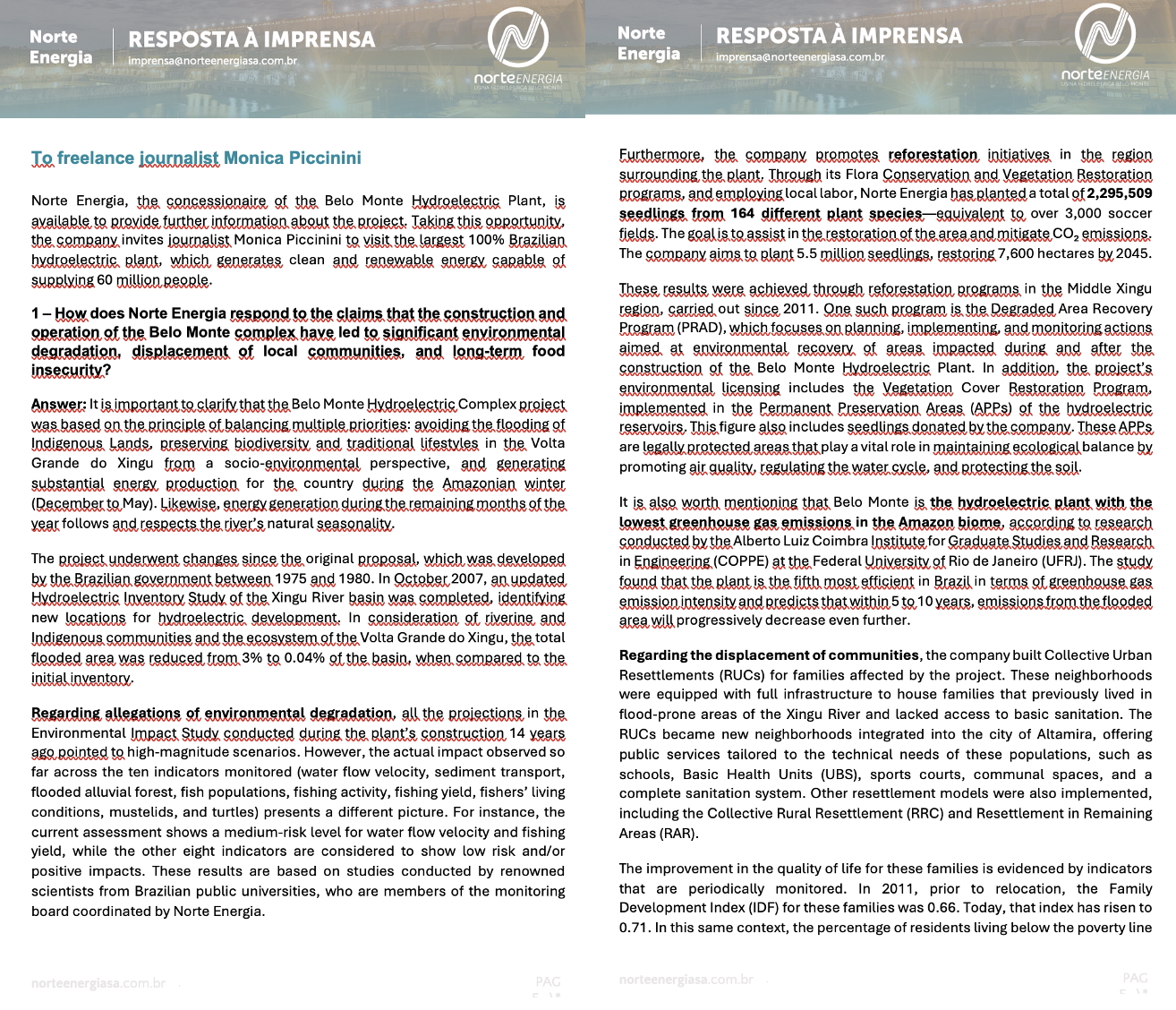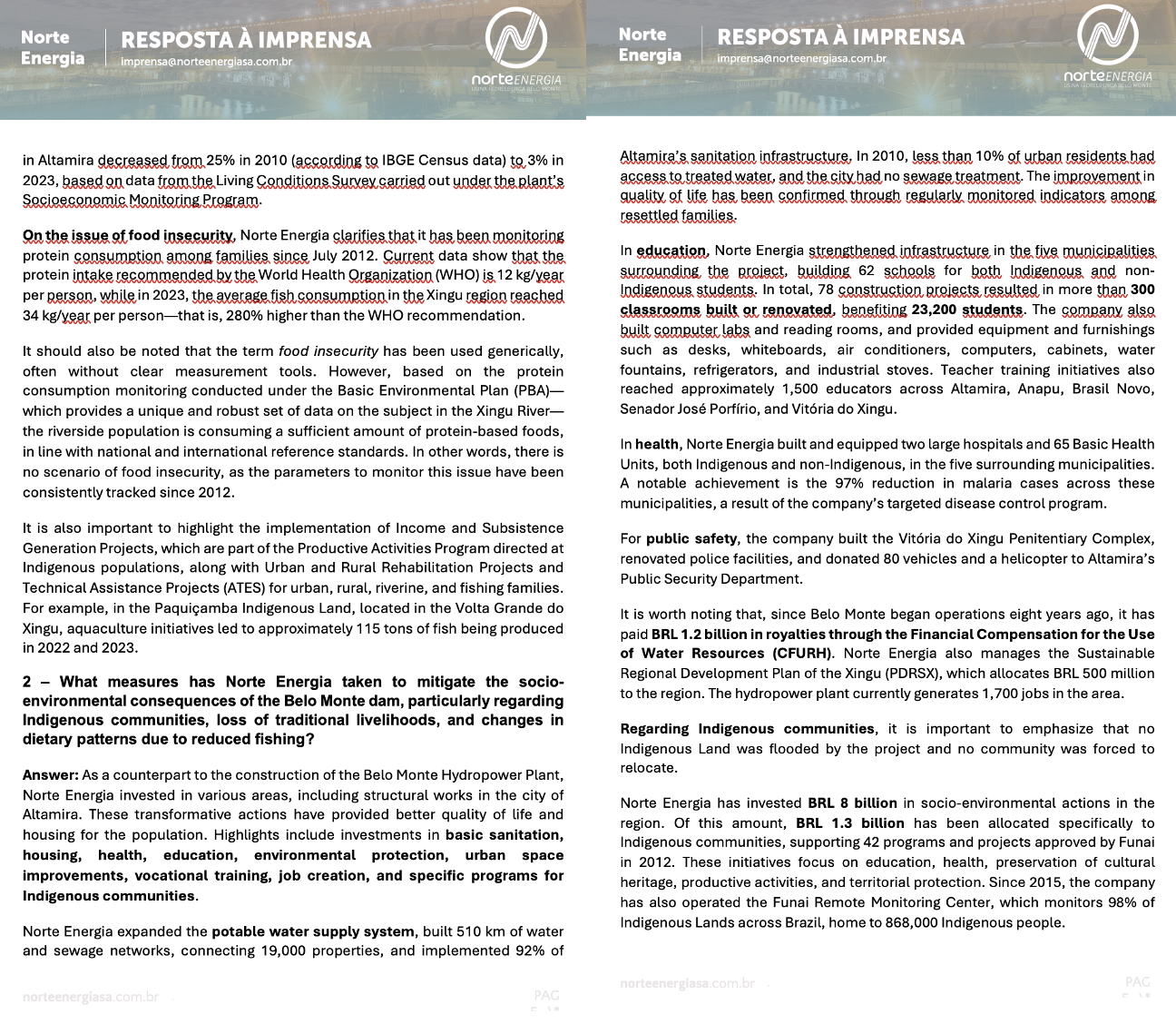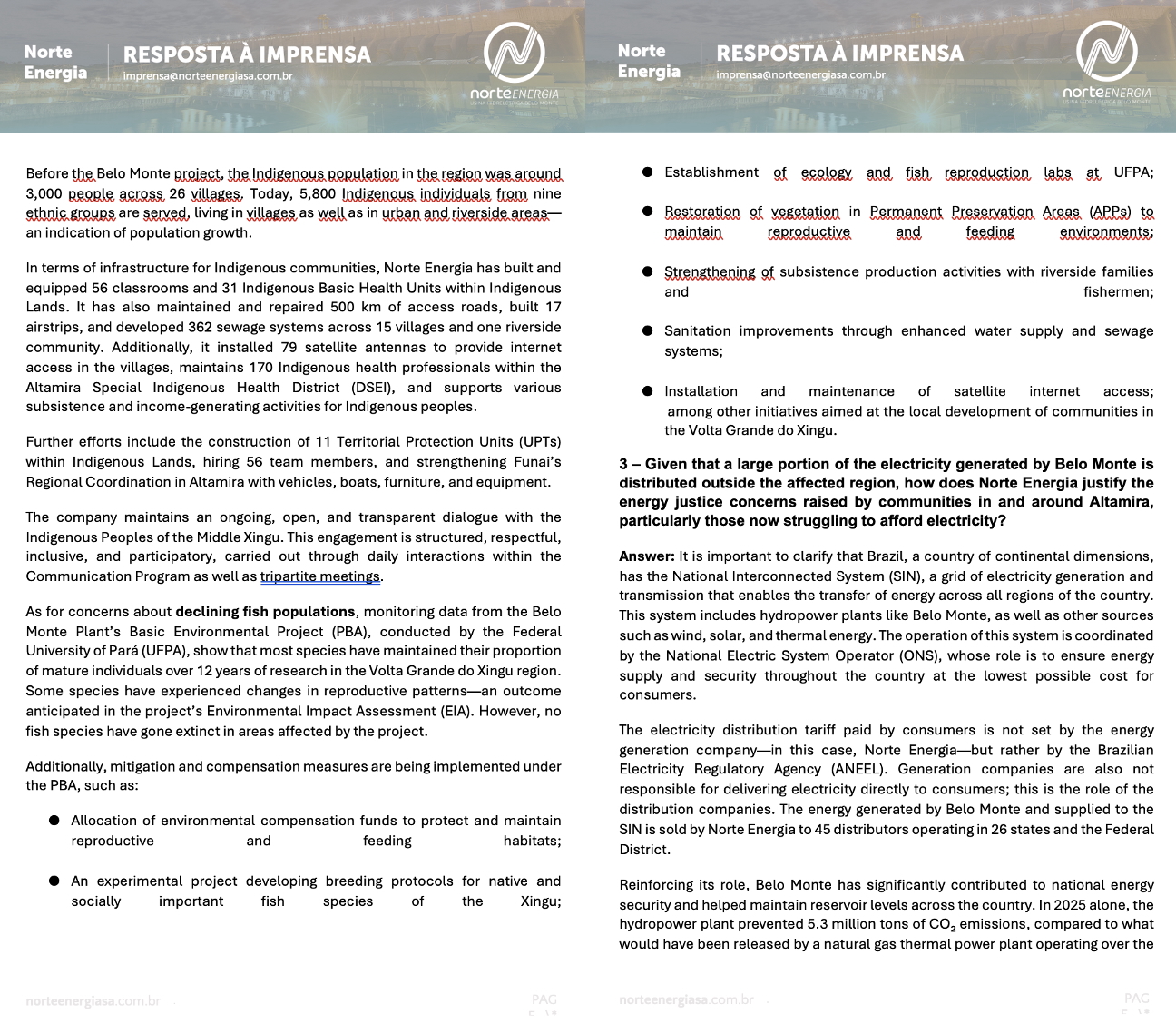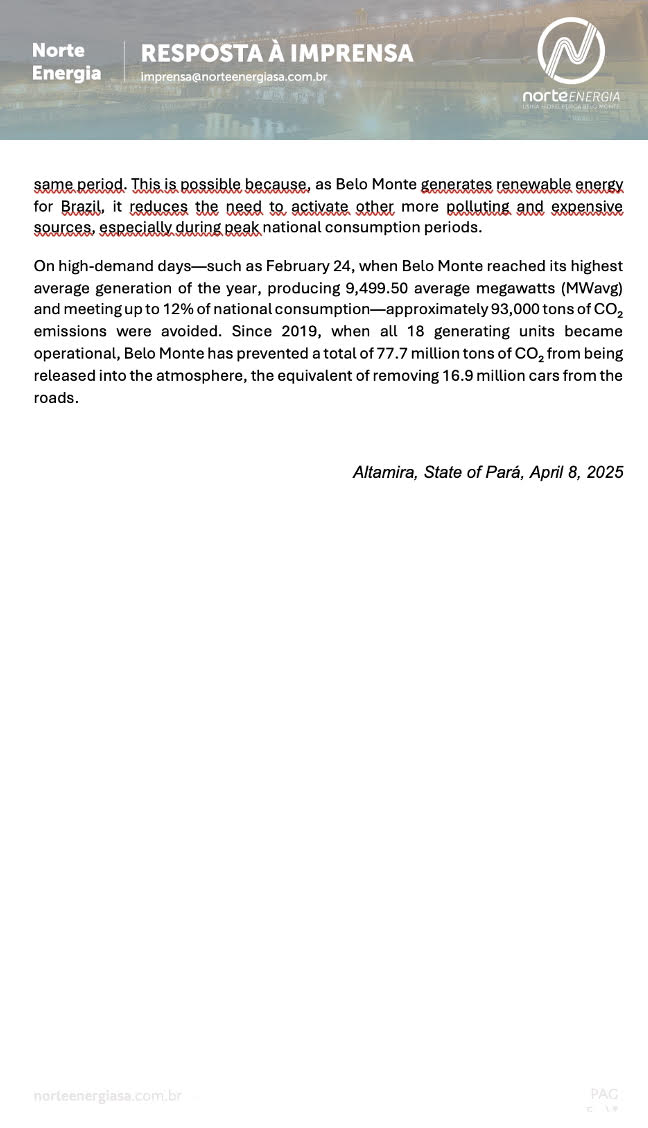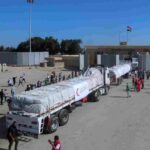As Brazil prepares to host COP30 in the city of Belém, it stands before the world as a self-declared leader in clean energy. The Amazon rainforest, often described as the lungs of the planet, has been at the heart of this vision, seen as a source of nearly limitless hydropower potential. For decades, Brazil has promoted hydroelectricity as a clean, sustainable, and cost-effective solution to boost economic growth and fulfil its climate commitments. But while hydropower now constitutes over 60% of Brazil’s energy matrix, this narrative of progress has come at a deep and often irreversible cost, one paid by ecosystems and communities that have long existed in harmony with the rivers now being harnessed for power.
Brazil’s hydropower dams: a story of displacement and destruction
The Brazilian government, energy companies, and mainstream media have long presented hydropower as a national achievement, a keystone of development and environmental responsibility. Yet, beneath the surface, scientific research and the lived experiences of countless displaced people tell a different story.
Since the 1960s, Brazil has invested heavily in dam construction, increasingly targeting the Amazon basin, one of the most ecologically rich and water-abundant areas on Earth. These gigantic projects have not only disrupted sensitive ecosystems but have also led to the mass displacement of Indigenous and traditional communities, disrupted their food sources, such as fishing, triggered widespread deforestation and environmental pollution. Worse yet, these dams contributed to the release of greenhouse gases like methane and carbon dioxide.
Furthermore, the influx of workers to dam sites often drives rapid urbanisation, placing stress on existing infrastructure and contributing to a surge in violence, crime, and both mental and physical health issues, leaving deep scars on communities that are already struggling to survive.
Belo Monte dam – a monumental loss
One of the most impactful projects, with significant irreversible socio-ecological consequences, was the construction of the Belo Monte hydroelectric complex in Pará, the host state for COP30.
Igor Cavallini Johansen, professor in the demography department of the State University of Campinas (UNICAMP), said:
We must reckon with the persistent inequalities created by large hydropower dams – both in the Altamira region and across the Amazon basin. This legacy of uneven development, where local communities bear the environmental and social costs while distant urban centres reap the energy benefits, demands urgent redress.
Built between 2010 and 2015 during Dilma Rousseff’s administration, and completed just before her impeachment, Belo Monte has a capacity of 11.2GW and a cost of around $13bn. It stands as Brazil’s second-largest hydropower plant, operated and managed by Norte Energia.
In June 2022, prior to his election, Brazil’s president Luiz Inácio Lula da Silva, stated that he had no regrets about supporting Belo Monte in the past, and that he would make the same decision to build the dam again if given the chance. He has consistently expressed his strong support for the Belo Monte project.
Belo Monte is made up of two dams: an upper dam, Pimental, which diverts water to the canal, and lower dam, Belo Monte, where the powerhouse is located, along a 130-km river stretch of the Xingu River, known as Volta Grande.
For many, Belo Monte symbolises tragedy, rather than triumph
The construction of Belo Monte forcibly displaced around 40,000 people, including riverside communities (Ribeirinhos) and a quarter of Altamira’s population, who were relocated to remote resettlements on the city’s outskirts.
For those who stayed, the consequences were equally devastating. Indigenous people and Ribeirinhos lost access to their primary food source – fishing – as fluctuating water levels led to the extinction of fish species. The river’s flow was reduced by an alarming 80%, all due to the diversion of its natural course.
Maria Francineide Ferreira dos Santos lost her paradise to silence. Her home in Paratizinho was taken from her after she dared to speak against the destruction caused by the Belo Monte dam. She was forced to move into the city, but never stopped fighting. Today, she lives in Volta Grande do Xingu, not just as a survivor, but as a fierce guardian of the river and its people.
Francineide spoke out about the lasting harm Belo Monte has brought to her life and the lives of countless others:
All the impacts we’ve had are irreparable. The first impact was the biggest crime that Belo Monte committed in the Xingu, the death of the fish and with the displacement of its people who were born and raised in this region, who lived on the islands, without rights, without being heard, without respect, having their houses ripped out and burned, violating our rights.
Another impact was seeing our people, who didn’t understand anything, lose their homes, being moved to the city where land had exorbitant prices, not giving us the conditions to survive. The government does what it wants. This has been a losing fight. No justice has been done.
Rodolfo Salm, ecologist, activist, and lecturer at the Federal University of Pará (UFPA), who lives in Altamira, spoke about some of the impacts of the project:
The Belo Monte hydroelectric project stands as a clear example of environmental, social, and economic failure. While presented as a symbol of progress, it has instead triggered widespread destruction in the eastern Amazon. The social consequences have been equally severe, marked by displacement, violence, and unfulfilled promises. Despite the billions spent on compensation, these efforts fall far short of addressing the loss of livelihoods, natural beauty, and vital ecosystem services once provided by the preserved Xingu River.
Far from bringing prosperity, the project has left the region economically weakened and environmentally damaged. Energy production at Belo Monte is unreliable, with the Xingu River running too low for most of the year, a flaw that was well understood before construction even began.
Food insecurity: stripped of a fundamental human right
A study published in the Environmental Research and Public Health journal highlights concerning levels of food insecurity in the region impacted by Belo Monte. Rather than enhancing quality of life, the project triggered a series of negative outcomes: displacement, loss of homes, and the disruption of essential food sources like agriculture and fishing. As a result, food security deteriorated, contributing to increased poverty.
Johansen, one of the authors of the study, explained:
The long-term food insecurity faced by communities displaced by Belo Monte is one of the most alarming consequences of the dam’s construction. Our research shows that, nearly 70% of households reported increased difficulty accessing enough food or the types of food they wanted after Belo Monte was built. For more than half of them, this struggle began even before the COVID-19 pandemic, meaning the dam’s impacts – not just external crises – are a relevant driver of this problem.
One of the most revealing findings is that people officially recognised as ‘impacted’ by Belo Monte – and thus relocated to government resettlement neighbourhoods – were significantly more likely to face hunger. This suggests that the resettlement process itself, rather than improving lives, has maintained or deepened vulnerabilities.
The resettled communities were stripped of a fundamental human right: access to adequate, nutritious food.
Deepening dependence on distant supply chains has been a disaster
Miquéias Freitas Calvi, professor of forestry engineering at the Federal University of Pará (UFPA), and one of the authors of the study, said:
The disruption of the river’s natural balance deeply affects the Indigenous and riverside communities whose lives are rooted in it. Fishing, their primary source of sustenance and income, is under threat, placing food security, health, and cultural survival at risk. As the river fades, so does their self-reliance. More families are forced to abandon their ancestral lands, relying on government aid to survive. Traditional diets give way to ultra-processed foods, compromising their health and identity. What begins as environmental damage quickly becomes a social crisis, eroding generations of sustainable living in harmony with the river.
In just two years, the city of Altamira’s population (urban area) doubled as thousands arrived from across Brazil, drawn by the promise of work, not only on the Belo Monte dam, but in the web of opportunities it created. With such rapid growth, the most basic human need, food, became a pressing challenge. Yet instead of preparing to sustain a growing city and strengthen the local economy, the region scaled back its food production and deepened its dependence on distant supply chains.
Johansen explained some of the impacts that go far beyond nutrition:
The loss of traditional food sources like fish has had devastating impacts that go far beyond nutrition – it’s severed a vital connection to cultural identity and community health. For Indigenous and riverine populations around Belo Monte, fish weren’t just protein; they anchored entire systems of knowledge, social bonds, and spiritual practices.
Generations developed intricate fishing techniques tied to the Xingu’s seasonal floods, passing down this wisdom through stories and shared labor. The act of fishing itself was communal – a space where elders taught youth, where myths were retold, where social ties were reinforced. With the dam’s disruption of river ecology, we’ve seen not just declining catches but a rupture in this intergenerational transmission.
Public perceptions of hydropower in Brazil
A study published in the Energy Research & Social Science journal explores how communities living near major hydropower dams perceive this form of energy, in sharp contrast to the broader national population. Focusing on the Altamira region, deep in the Amazon and heavily impacted by the Belo Monte dam, the study offers a glimpse into the lived reality behind Brazil’s hydropower narrative.
Although Altamira is not located directly beside the dam, it served as a central hub for its construction. As a result, the city experienced significant negative impacts, including the rise in crime, prostitution, drug use, public health challenges such as increased dengue fever cases, and social disruption.
Having lived through these changes, Altamira’s residents perceive the social and environmental consequences of hydropower far more critically than the general population. Still, 60% of residents continue to express support for hydropower, a complex and conflicted relationship with a project that has profoundly altered their daily lives.
This contradiction reveals the harsh reality of “sacrifice zones”, areas like Altamira and its neighbouring communities that are left to absorb the full cost of national development while receiving little in return. The psychological cost is profound: some residents appear to cope by believing their hardship is a necessary contribution to the nation’s progress.
Perhaps most heartbreaking is the widespread frustration over energy costs. A staggering 84% of Altamira’s population say they are dissatisfied with the affordability of electricity, despite living in the shadow of one of the world’s largest hydropower projects.
The ‘narrative of progress and modernity’
Johansen further explained:
There’s the powerful narrative of progress and modernity that dominates media coverage and political discourse. Hydropower is consistently framed as “clean energy” and a driver of national development, with stories appearing almost exclusively in economic sections of newspapers. This selective coverage emphasises job creation and energy security while minimising reports about displacement, ecological damage, and cultural loss. The result is a skewed public perception where the benefits feel abstract and national, while the costs remain hyper-localised.
In addition, there’s the entrenched notion of sacrifice zones – the idea that certain regions must bear the burden of development for the greater good. Many in Altamira express a resigned acceptance that “someone has to pay the price” for Brazil’s energy needs. This sentiment is reinforced when they see the electricity from Belo Monte, which is connected to the national grid, primarily powering distant urban centers in the southeast while there are local communities in the Amazon facing energy poverty.
The stark reality of Altamira – sitting in the shadow of one of Brazil’s largest hydropower plants yet struggling with expensive electricity – exposes a fundamental injustice in our energy system. This isn’t just poor planning; it’s a systemic failure that treats local communities as infrastructure sites rather than equal beneficiaries.
As Brazil prepares to welcome the world at COP30, it faces an urgent question: can a nation truly claim climate leadership while ignoring the voices of those sacrificed in the name of energy?
We can ‘no longer justify sacrificing’ the Amazon for hydropower in Brazil
Johansen’s shared a powerful message to Brazil and the world about the irreversible consequences of hydropower dams in biodiversity hotspots like the Amazon:
The construction of hydropower dams in biodiversity hotspots like the Amazon has taught us several hard lessons that should fundamentally reshape future energy planning. First and foremost, these projects cause irreversible ecological damage – flooding vast areas of pristine rainforest, destroying unique habitats, and potentially driving species extinction.
Equally troubling is the consistent pattern of human rights violations. Indigenous and traditional communities repeatedly face displacement without proper consultation or fair compensation, as starkly demonstrated by the Belo Monte project. These aren’t isolated incidents but systemic failures in how such projects are approved and implemented.
The climate calculus for tropical dams has also proven flawed. Rather than being clean energy solutions, their reservoirs become methane factories as submerged vegetation decomposes – in some cases making them worse climate offenders than fossil fuel plants. This challenges the very rationale for prioritising hydropower in rainforest regions.
Perhaps the most crucial lesson is that we can no longer justify sacrificing the Amazon’s ecological and cultural wealth for questionable energy gains. The evidence clearly shows that in biodiversity hotspots, the costs of large dams nearly always outweigh the benefits – a reality that demands a fundamental shift in energy policy.
When asked for comment, Norte Energia issued to following statement:
